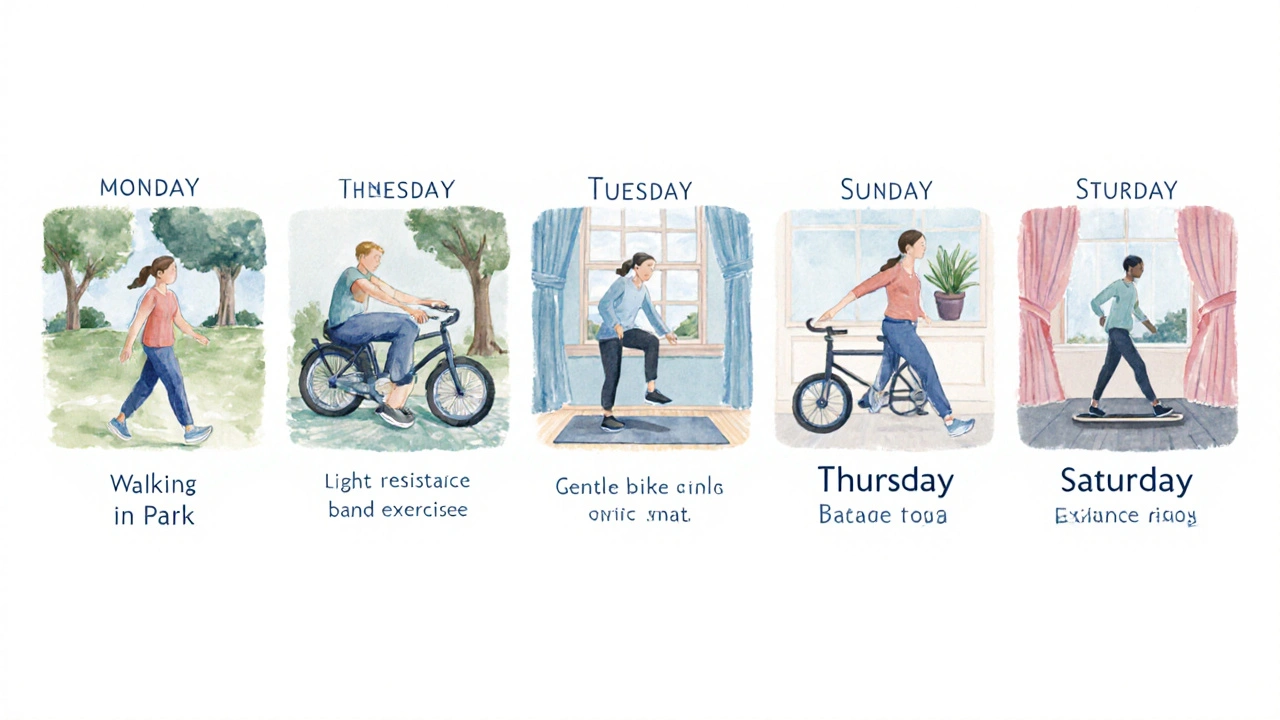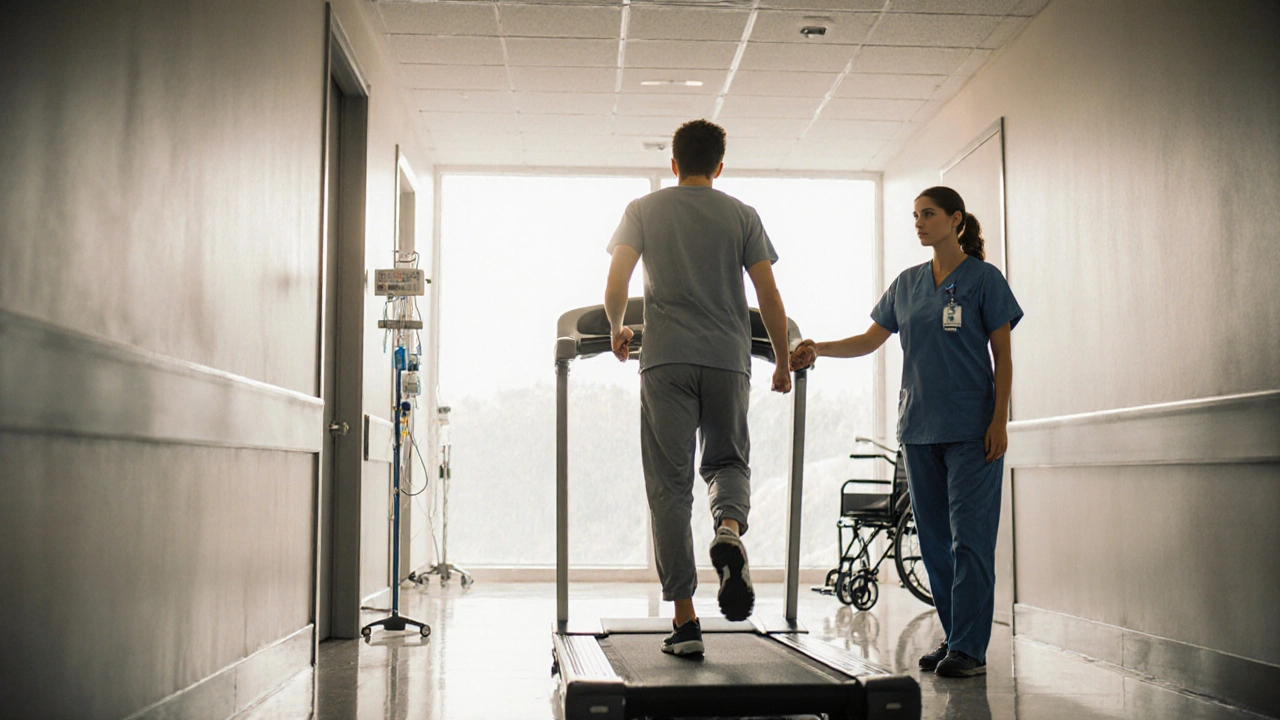Rhabdomyosarcoma Exercise Planner
Daily Exercise Recommendation
Recommended Activity
Based on your inputs, we recommend starting with gentle walking or stretching for 10-15 minutes.
Intensity Level (RPE Scale)
Very Light
Light
Moderate
Hard
Very Hard
Safety Considerations
- Consult your oncology team before starting
- Listen to your body and rest when needed
- Stay hydrated throughout the day
- Wear comfortable, supportive shoes
Start Duration
Begin with 5-10 minutes per session and gradually increase by 5 minutes each week if tolerated.
Weekly Exercise Schedule
| Day | Activity | Duration | Intensity (RPE) |
|---|---|---|---|
| Monday | Gentle Walking or Stretching | 10-15 min | 3-4 |
| Tuesday | Resistance Band Work | 10 min | 3-4 |
| Wednesday | Rest or Gentle Stretching | 5-10 min | 1-2 |
| Thursday | Stationary Cycling | 10-15 min | 3-4 |
| Friday | Yoga Flow | 15-20 min | 2-3 |
| Saturday | Balance & Core Drills | 10 min | 3-4 |
| Sunday | Free Choice | Varies | Varies |
Fatigue Management Tips
Energy Optimization
- Schedule activity during peak energy hours
- Break sessions into micro-chunks (5-minute walks)
- Take short naps if needed
- Engage in gentle stretching before bed
Motivation Strategies
- Set tiny, achievable daily goals
- Celebrate small wins
- Join online cancer-exercise communities
- Use a buddy system for motivation
When facing rhabdomyosarcoma is a rare soft‑tissue cancer that primarily affects children and adolescents. It arises from skeletal muscle cells and often requires a mix of surgery, chemotherapy, and sometimes radiation therapy. While treatment attacks the tumor, it also taxes the body, leaving many patients exhausted and wary of moving. Yet, staying active can actually help the body cope better with the aggressive therapy.
Key Takeaways
- Ask your oncologist before starting any exercise program.
- Begin with gentle, low‑impact activities and build up slowly.
- Focus on movement that reduces fatigue, preserves muscle strength, and supports mood.
- Listen to your body-rest when needed and modify exercises during bad days.
- Lean on physiotherapists, support groups, and online resources for guidance.
Why Staying Active Helps
Exercise isn’t just about keeping weight off; it triggers a cascade of physiological benefits that matter during cancer treatment:
- Reduces treatment‑related fatigue - Light aerobic work boosts circulation and oxygen delivery, making everyday tasks feel easier.
- Preserves muscle strength - Maintaining muscle mass counters the catabolic effects of chemotherapy.
- Improves mood and reduces anxiety by releasing endorphins, which can lessen the emotional toll of a cancer diagnosis.
- Supports immune function, giving the body an extra edge while white‑blood‑cell counts fluctuate.
- Enhances flexibility and joint health, reducing the risk of injuries when bedside transfers become necessary.
Safety First: Getting Medical Clearance
Before lacing up sneakers, schedule a brief consultation with your oncology team. They’ll look at:
- Current blood counts - low platelet or neutrophil levels may require a pause on high‑impact work.
- Location of the tumor and any surgical sites - certain positions might be uncomfortable or risky.
- Side‑effects you’re experiencing - nausea, neuropathy, or severe bone pain can dictate the type of movement that’s safe.
Ask for written guidelines; many hospitals provide a “Exercise Prescription” sheet that outlines permitted intensity levels (usually expressed as a percentage of heart rate reserve).

Choosing the Right Types of Exercise
Here’s a quick rundown of low‑risk activities that research shows are well‑tolerated by pediatric and adolescent cancer patients:
- Walking or gentle treadmill work - 10‑20 minutes at a comfortable pace, three to five times a week.
- Stationary cycling - Keeps the legs moving without weight‑bearing stress.
- Resistance bands - Light to medium resistance (1‑5lb) helps maintain arm and leg strength without overloading joints.
- Yoga and stretching - Focus on breath‑centered poses that improve flexibility and reduce muscle tightness.
- Balance drills - Simple single‑leg stands or heel‑to‑toe walks improve proprioception, useful if you feel “off‑balance” from medication.
Each activity can be adjusted based on your daily energy levels. For example, on a good day you might walk 30 minutes, while on a tougher day a 5‑minute stroll still counts.
Building a Simple Routine
Start with a starter pack that fits into a typical treatment week:
| Day | Activity | Duration | Intensity (RPE 1‑10) |
|---|---|---|---|
| Monday | Walk outdoors or on treadmill | 15min | 3‑4 |
| Tuesday | Resistance band circuit (upper & lower body) | 10min | 4‑5 |
| Wednesday | Rest or gentle stretching | 5‑10min | 1‑2 |
| Thursday | Stationary bike | 15min | 3‑4 |
| Friday | Yoga flow (focus on breathing) | 20min | 2‑3 |
| Saturday | Balance & core drills | 10min | 3‑4 |
| Sunday | Free choice - walk, stretch, or rest | Varies | Varies |
Key points:
- Start with 5‑10 minutes per session; add 5 minutes each week if you feel good.
- Use the Rate of Perceived Exertion (RPE) scale-aim for 3‑4 on most days.
- Hydrate before, during, and after activity; a sip of water every 10 minutes helps prevent dizziness.
Managing Fatigue and Other Side Effects
Fatigue is the most common complaint during chemotherapy. Here are practical tricks:
- Schedule activity for “peak” energy windows - many patients feel a boost after a good night's sleep or a few hours post‑medication.
- Break sessions into micro‑chunks - three 5‑minute walks spread throughout the day can feel less daunting than one long stroll.
- Incorporate gentle stretching before bed to reduce muscle stiffness that can exacerbate tiredness.
- Use a “buddy system” - a family member or friend can motivate you and keep an eye on safety.
- Pay attention to neuropathy - if your feet feel tingly, choose seated cycling or upper‑body band work instead of walking.

Nutrition & Hydration to Support Activity
Fuel matters. When treatment disrupts appetite, aim for small, protein‑rich snacks that are easy to digest:
- Greek yogurt with a handful of berries.
- Peanut butter on whole‑grain toast.
- Smoothies blended with whey protein, banana, and almond milk.
Electrolyte drinks can be useful if you’re sweating during a bike session. Keep a log of what you eat before and after exercise; patterns often emerge that show what works best for your energy levels.
Getting Professional Support
Integrating a qualified physiotherapist or a certified oncology exercise specialist can make a huge difference. They can:
- Perform a baseline functional assessment (range of motion, balance, strength).
- Customize a program that respects surgical sites and radiation fields.
- Teach safe techniques for breathing, posture, and equipment use.
Many hospitals now run “Exercise Oncology” clinics; if yours doesn’t, look for community rehab centers that have experience with pediatric oncology patients.
Exercise Safety Checklist
| Check | Yes/No | Notes |
|---|---|---|
| Medical clearance obtained today | ||
| Feeling less than 38°C (100.4°F) temperature | ||
| Platelet count > 50,000/µL | Ask nurse if unsure | |
| No new pain or swelling at surgical site | ||
| Hydrated (urine light yellow) | ||
| Comfortable clothing and supportive shoes |
Use this worksheet each morning. If any answer is “No,” modify or postpone the session and talk to your care team.
Frequently Asked Questions
Can I exercise on days when I receive chemotherapy?
Yes, but keep it light. A 10‑minute walk or gentle stretching right after treatment often feels better than staying still all day. Avoid heavy lifting or high‑intensity cardio when you notice nausea or dizziness.
What if I develop a fever or infection?
Stop all activity until you’ve spoken with your oncologist. Fever can signal an infection, and exercising while febrile may worsen your condition.
Is it safe to use a treadmill if I have a central line?
Protect the line with a waterproof cover and avoid jarring movements. Many patients prefer a stationary bike to reduce the risk of tugging the catheter.
How can I stay motivated during long treatment cycles?
Set tiny, achievable goals-like completing three minutes of walking each day. Celebrate each win with a favorite treat or a short video call with friends. Joining an online cancer‑exercise community can also give you daily pep talks.
Should I wear a support brace or compression garment during activity?
If your surgeon prescribed a brace for a specific limb, wear it as directed. Compression sleeves can help with lymphedema, but only use them if a physiotherapist has approved the level of compression.
Staying active while battling rhabdomyosarcoma isn’t about becoming a marathon runner. It’s about moving enough to protect muscle, lift mood, and give your body the best chance to tolerate tough treatments. With medical clearance, a simple routine, and a supportive team, you can keep the momentum going-one step at a time.


Erica Ardali
October 5, 2025 AT 18:40In the theater of healing, every tentative step becomes a stanza in the epic of survival; the gentle walk is not merely movement, it is a declaration of defiance against the insidious whispers of disease. One must honor the sacrosanct covenant between body and mind, lest the fragile flesh surrender to inertia. The prescribed ten to fifteen minutes of mild activity echo the ancient philosophers' call for measured moderation. Let the rhythmic cadence of one's breath be the metronome of resolve, and the humble stretch the parchment upon which hope is inscribed.
Justyne Walsh
October 9, 2025 AT 04:40Oh, because nothing screams "I'm thriving" like a carefully curated weekly schedule that looks like it was drafted by a corporate wellness bot. “Consult your oncologist,” they say-sure, as if the oncologist has time to sign off on a five‑minute stroll. If you’ve survived chemo, you’ve already proven you can handle a little fatigue, so maybe don’t turn every walk into a moral crusade. Sarcasm aside, a little movement is better than a complete couch‑potato existence.
Mimi Saki
October 12, 2025 AT 14:40Hey there, I just want to say you’re doing an amazing job juggling treatment and staying active! 🌟 Remember to sip water often and listen to your body-if something feels off, it’s totally okay to take a rest day. Celebrate the tiny victories, like completing a 5‑minute walk, because those little wins add up to big strength over time. Keep that smile on, you’ve got a whole community cheering you on! 😊
Subramaniam Sankaranarayanan
October 16, 2025 AT 00:40The physiologic rationale for low‑impact exercise during rhabdomyosarcoma therapy is rooted in the preservation of mitochondrial density in skeletal muscle. Chemotherapeutic agents such as vincristine and actinomycin D can precipitate myopathy, which manifests as reduced contractile force and endurance. By engaging in brief bouts of aerobic activity, circulating hemoglobin levels are optimized, thereby enhancing oxygen delivery to both tumor and healthy tissue. This improved oxygenation can mitigate hypoxia‑driven resistance mechanisms within the malignant cells, a phenomenon observed in several preclinical models. Moreover, light resistance training with bands stimulates mechanotransduction pathways, notably the mTOR cascade, which supports anabolic processes essential for maintaining lean body mass. The RPE scale, targeting a perceived exertion of 3‑4, ensures that autonomic stress remains within a safe window, avoiding excessive catecholamine surges that could exacerbate tachycardia. Hydration plays a pivotal role; a deficit of even 2% body weight can impair thermoregulation, leading to dizziness during otherwise benign activity. Nutritional timing is equally important-consuming a protein‑rich snack within thirty minutes post‑exercise can augment muscle protein synthesis, counteracting catabolic effects of glucocorticoids often prescribed alongside chemotherapy. From a psychosocial perspective, the structured routine provides a sense of agency, reducing the learned helplessness that can accompany prolonged hospitalization. Peer support, whether through online forums or bedside companions, further enhances adherence by offering real‑time encouragement and shared coping strategies. Safety precautions must be individualized; for patients with central venous catheters, activities that involve abrupt arm movements should be avoided to prevent line dislodgement. Similarly, if radiation has targeted a specific limb, the use of compression garments may be contraindicated due to skin fragility in that region. Periodic assessment by a physical therapist allows for progressive overload while ensuring that joint ranges of motion remain uncompromised. Documentation of daily activity, symptoms, and any adverse events creates a valuable data set for clinicians to fine‑tune the exercise prescription. Ultimately, the synergy of modest physical activity, vigilant monitoring, and multidisciplinary collaboration transforms exercise from an optional add‑on into a cornerstone of comprehensive cancer care.
Jennifer Wees-Schkade
October 19, 2025 AT 10:40That overview hits the nail on the head-especially the point about tailoring activity around central line placement. In practice, we ask patients to secure the line with a soft silicone holder and avoid any jerky motions. A quick pre‑session checklist that includes temperature, platelet count, and pain assessment can catch issues before they become setbacks. If any of those parameters are out of range, swapping a walking session for a seated stretching routine preserves momentum without risking injury. Consistency, not intensity, is the real driver of benefit during treatment.
Kylie Holmes
October 22, 2025 AT 20:40Exactly! Keep the momentum going, even if it’s just marching in place while watching your favorite show. Celebrate each mini‑victory-maybe treat yourself to a warm cup of tea after a session. Your body will thank you with a little extra stamina the next day, and you’ll feel more in control of the whole process. You’ve got this, keep shining!
Patrick Hendrick
October 26, 2025 AT 06:40Great points!; Remember, consistency beats perfection; Small steps matter.; Stay hydrated.; Listen to your body.; Keep moving!
Patrick Rauls
October 29, 2025 AT 16:40yeah totally get it lol, sometimes a 5‑min walk feels like a marathon when you’re chemo‑fried 😂 just remember to wear comfy shoes and take it easy-no need to push hard rn.
Asia Lindsay
November 2, 2025 AT 02:40Listen, the key is to make exercise feel like a reward, not a chore. Start each day with a brief warm‑up-maybe arm circles while you’re sipping your morning coffee. Set a simple goal, like “walk for 10 minutes before lunch,” and tick it off on a habit tracker. If you’re feeling low, swap the walk for a gentle yoga flow; the movement still triggers endorphins. Celebrate each check‑off with a fun playlist or a quick text to a friend. Over time, those little habits stack into real strength and confidence.
Angela Marie Hessenius
November 5, 2025 AT 12:40When one reflects upon the ancient practices of the Japanese shinrin‑yoku, or forest bathing, it becomes evident that movement intertwined with nature has long been a conduit for both physical vitality and spiritual equilibrium; indeed, the modern patient battling rhabdomyosarcoma may find an unexpected ally in the humble act of strolling beneath a canopy of trees, breathing in the pine‑scented air, and allowing the rhythmic cadence of footsteps to echo the timeless drumbeat of resilience that has carried humanity through countless plagues. In the same vein, the Mediterranean tradition of leisurely paseos, where families ambulate through sun‑kissed streets while engaging in light conversation, offers a template for integrating social connection with low‑impact activity-an approach that not only nurtures musculoskeletal health but also fortifies the emotional bulwark essential for enduring intensive therapies. Moreover, the indigenous Maori haka, though often perceived as a fierce war dance, contains within its choreography gentle footwork and breath‑synchronised movements that can be adapted into a low‑intensity regimen, honoring cultural heritage while delivering measurable benefits in balance and proprioception. By weaving these cross‑cultural threads into a personalized exercise tapestry, patients can transcend the sterile confines of hospital rooms, drawing upon a global reservoir of wisdom that celebrates the unity of body, mind, and community.
Julian Macintyre
November 8, 2025 AT 22:40From an evidence‑based perspective, the integration of structured aerobic activity within oncologic treatment protocols demonstrates a statistically significant reduction in reported fatigue scores, as corroborated by multiple randomized controlled trials. The methodological rigor of these studies underscores the necessity for precise intensity prescription, often operationalized via the Rate of Perceived Exertion (RPE) scale. Compliance monitoring, facilitated through patient‑reported outcome measures, further validates the therapeutic efficacy of such interventions. Consequently, the recommendation to incorporate gentle walking or low‑impact cycling aligns with contemporary clinical guidelines and warrants implementation across treatment centers.
Fr. Chuck Bradley
November 12, 2025 AT 08:40Even the smallest stride can become a quiet triumph over the illness.